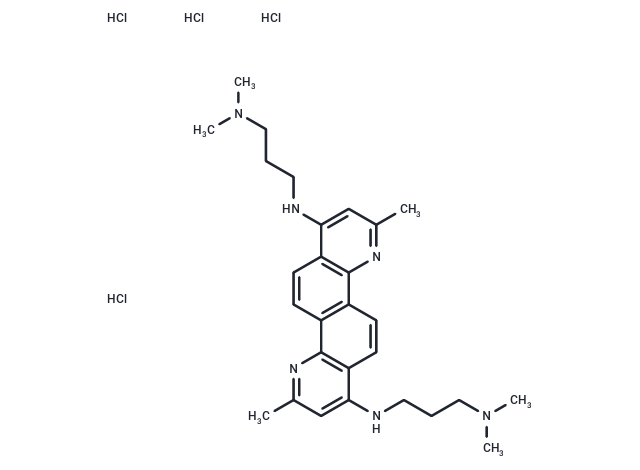Shopping Cart
- Remove All
 Your shopping cart is currently empty
Your shopping cart is currently empty

FGI-106 tetrahydrochloride demonstrates potent inhibitory activity across a broad spectrum of viruses, including those causing hemorrhagic fevers such as Ebola, Rift Valley, and Dengue Fever, with half-maximal effective concentrations (EC50s) of 100 nM, 800 nM, and 400-900 nM, respectively. Additionally, it effectively inhibits non-hemorrhagic fever viruses, notably HCV and HIV-1, with EC50s of 200 nM and 150 nM, respectively, indicating its broad-spectrum antiviral potential.

| Pack Size | Price | Availability | Quantity |
|---|---|---|---|
| 1 mg | 75 € | In Stock | |
| 5 mg | 164 € | In Stock | |
| 10 mg | 259 € | In Stock | |
| 25 mg | 429 € | In Stock | |
| 50 mg | 604 € | In Stock | |
| 100 mg | 815 € | In Stock | |
| 200 mg | 1.092 € | In Stock | |
| 1 mL x 10 mM (in DMSO) | 218 € | In Stock |
| Description | FGI-106 tetrahydrochloride demonstrates potent inhibitory activity across a broad spectrum of viruses, including those causing hemorrhagic fevers such as Ebola, Rift Valley, and Dengue Fever, with half-maximal effective concentrations (EC50s) of 100 nM, 800 nM, and 400-900 nM, respectively. Additionally, it effectively inhibits non-hemorrhagic fever viruses, notably HCV and HIV-1, with EC50s of 200 nM and 150 nM, respectively, indicating its broad-spectrum antiviral potential. |
| Targets&IC50 | EBOV:(EC50)100 nM , DENV: 400-900 nM , HIV-1:150 nM , HCV: 200 nM , Rift Valley virus: 800 nM |
| In vitro | In cell-based assays, treatment with FGI-106 inhibits viral replication by divergent virus families, including positive and negative-strand RNA viruses.Treatment with 2 μM FGI-106 mediated a 4 log reduction in infectious viral titers relative to matched controls, with an EC90 for inhibition of viral killing of host cells (Vero E6 cells) estimated to be 0.6 μM. |
| In vivo | FGI-106??treatment decreases mortality from Zaire EBOV in a dose-dependent manner. |
| Molecular Weight | 604.48 |
| Formula | C28H42Cl4N6 |
| Cas No. | 1149348-10-6 |
| Smiles | Cl.Cl.Cl.Cl.CN(C)CCCNc1cc(C)nc2c1ccc1c2ccc2c(NCCCN(C)C)cc(C)nc12 |
| Relative Density. | no data available |
| Storage | Powder: -20°C for 3 years | In solvent: -80°C for 1 year | Shipping with blue ice. | ||||||||||||||||||||
| Solubility Information | DMSO: 7.5 mg/ml (12.41 mM), Sonication is recommended. | ||||||||||||||||||||
Solution Preparation Table | |||||||||||||||||||||
DMSO
| |||||||||||||||||||||

Copyright © 2015-2025 TargetMol Chemicals Inc. All Rights Reserved.